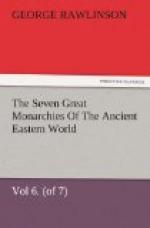The successor of Volagases I. was Pacorus, whom most writers on Parthian history have regarded as his son. There is, however, no evidence of this relationship; and the chief reason for regarding Pacorus as belonging even to the same branch of the Arsacidse with Volagases I. is his youth at his accession, indicated by the beardless head upon his early coins, which is no doubt in favor of his having been a near relation of the preceding king. PLATE III., Fig 1. The Parthian coins show that his reign continued at least till A.D. 93; it may have lasted considerably longer, for the earliest date on any coin of Chosroes is AEr. Seleuc. 421, or A.D. 110. The accession of Chosroes has been conjecturally assigned to A.D. 108, which would allow to Pacorus the long reign of thirty years. Of this interval it can only be said that, so far as our knowledge goes, it was almost wholly uneventful. We know absolutely nothing of this Pacorus except that he gave encouragement to a person who pretended to be Nero; that he enlarged and beautified Otesiphon; that he held friendly communications with Decebalus, the great Dacian chief, who was successively the adversary of Domitian and Trajan; and that he sold the sovereignty of Osrhoene at a high price to the Edessene prince who was cotemporary with him. The Pseudo-Nero in question appears to have taken refuge with the Parthians in the year A.D. 89, and to have been demanded as an impostor by Domitian. Pacorus was at first inclined to protect and to even assist him, but after a while was induced to give him up, probably by a threat of hostilities. The communication with the Dacian chief was most likely earlier. The Dacians, in one of those incursions into Maesia which they made during the first years of Domitian, took captive a certain Callidromus, a Greek, if we may judge by his name, slave to a Roman of some rank, named Liberius Maximus. This prisoner Decebalus (we are told) sent as a present to Pacorus, in whose service and favor he remained for a number of years. This circumstance, insignificant enough in itself, acquires an interest from the indication which it gives of intercommunication between the enemies of Rome, even when they were separated by vast spaces, and might have been thought to have been wholly ignorant of each other’s existence. Decebalus can scarcely have been drawn to Pacorus by any other attraction than that which always subsists between enemies of any great dominant power. He must have looked to the Parthian monarch as a friend who might make a diversion on his behalf upon occasion; and that monarch, by accepting his gift, must be considered to have shown a willingness to accept this kind of relation.




